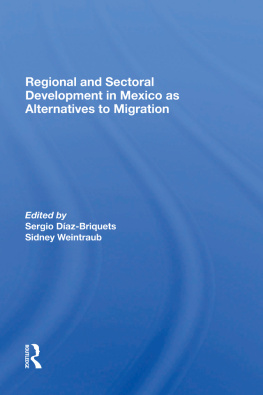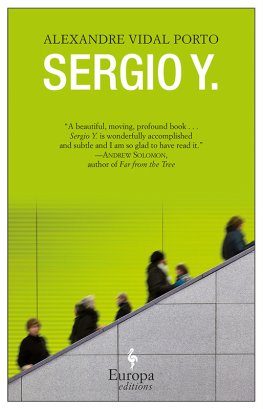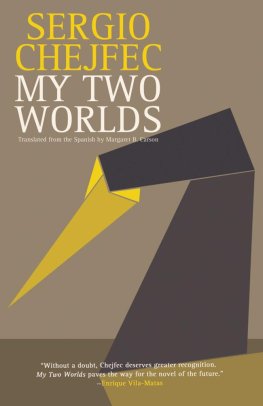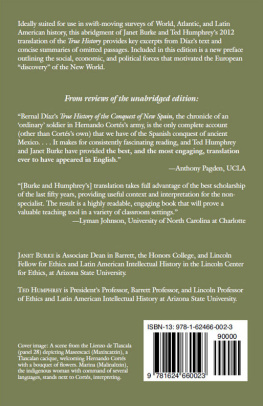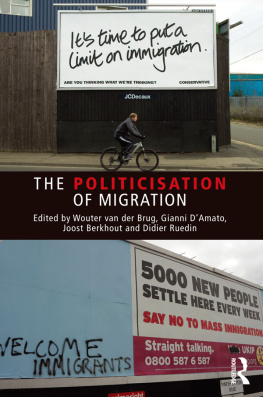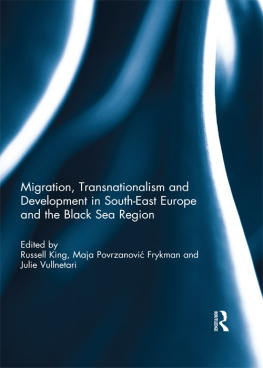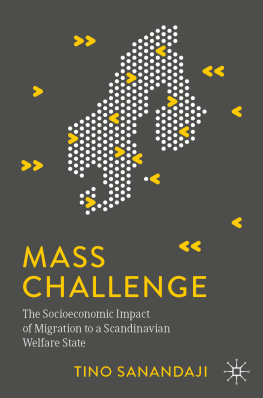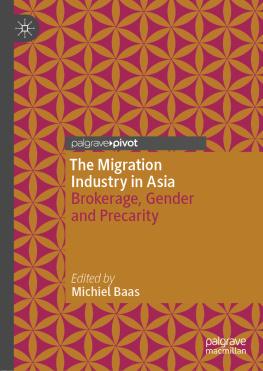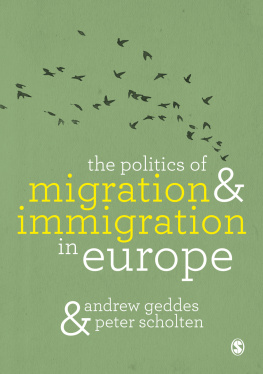The Effects of Receiving Country Policies on Migration Flows
Series on Development and International Migration in Mexico, Central America, and the Caribbean Basin
Sergio Daz-Briquets and Sidney Weintraub, Series Editors
Volume I
Determinants of Emigration from Mexico, Central America, and the Caribbean
Volume II
Regional and Sectoral Development in Mexico as Alternatives to Migration
Volume III
Migration Impacts of Trade and Foreign Investment: Mexico and Caribbean Basin Countries
Volume IV
Migration, Remittances, and Small Business Development: Mexico and Caribbean Basin Countries
Volume V
Small Country Development and International Labor Flows: Experiences in the Caribbean, edited by Anthony P. Maingot
Volume VI
The Effects of Receiving Country Policies on Migration Flows
First published 1991 by Westview Press
Published 2019 by Routledge
52 Vanderbilt Avenue, New York, NY 10017
2 Park Square, Milton Park, Abingdon, Oxon OX14 4RN
Routledge is an imprint of the Taylor & Francis Group, an informa business
Copyright 1991 Taylor & Francis
All rights reserved. No part of this book may be reprinted or reproduced or utilised in any form or by any electronic, mechanical, or other means, now known or hereafter invented, including photocopying and recording, or in any information storage or retrieval system, without permission in writing from the publishers.
Notice:
Product or corporate names may be trademarks or registered trademarks, and are used only for identification and explanation without intent to infringe.
Library of Congress Cataloging-in-Publication Data
The effects of receiving country policies on migration flows / edited
by Sergio Daz-Briquets and Sidney Weintraub.
p. cm. (Series on development and international migration
in Mexico, Central America, and the Caribbean Basin ; 6)
1. Aliens, IllegalUnited States. 2. United StatesEmigration
and immigrationEconomic aspects. 3. MexicoEmigration and
immigrationEconomic aspects. 4. Central AmericaEmigration and
immigrationEconomic aspects. 5. Caribbean AreaEmigration and
immigrationEconomic aspects. I. Daz-Briquets, Sergio.
II. Weintraub, Sidney, 1922- . III. Series.
JV6493.E45 1991
325.73dc20
91-8644
CIP
ISBN 13: 978-0-367-29164-8 (hbk)
Contents
, Sergio Daz-Briquets and Sidney Weintraub
, Sergio Daz-Briquets and Sidney Weintraub
, Sidney Weintraub
, Terry L. McCoy
, Mario M. Carrillo Huerta
, Gary D. Thompson and Philip L. Martin
, Luin Goldring
, Luisa Gabayet and Silvia Lailson
, Mercedes Gonzlez de la Rocha and Agustn Escobar Latap
, Rosemarie Rogers
, Georges Photios Tapinos
Guide
The Immigration Reform and Control Act of 1986 (IRCA) was a manifestation of widespread public concern over the volume of undocumented immigration into the United States. The principal innovation of this legislationthe provision to impose penalties on employers who knowingly hire undocumented immigrantswas a response to this concern.
This effort at restriction was tempered in IRCA by other provisions permitting the legalization of two types of undocumented immigrants those who had resided in the United States since January 1, 1982; and what were called special agricultural workers (SAWs), persons who had worked in perishable crop agriculture for at least 90 days during specified periods from 1983 to 1986. Approximately 3.1 million persons sought legalization (what is popularly referred to as amnesty) under these two provisions. The breakdown was roughly 1.8 million under the regular program and 1,3 million as SAWs. Mexicans made up 75 percent of the combined legalization requests.
Two elementspunishment and exonerationwere essential ingredients of the compromise that made possible the passage of IRCA, but they also had the effect of working at cross purposes, at least temporarily. For a time, many persons who might have crossed the border without papers took the opportunity to regularize their status and thus enter legally. In our research we discovered many non-farmers who had not earlier considered temporary migration but who obtained papers as SAWs to enter the United States. Officials of the U.S. Immigration and Naturalization Service (INS) asserted that there was widespread fraud under the SAWs program for applicants from Mexico and elsewhere. We verified from the Mexican side of the border that, indeed, there was fraud, but our evidence does not permit making an estimate of its magnitude. The two provisions together did not slow immigration but instead permitted some switching from undocumented to documented border crossing. During the period that legalization applications could be submitted, therefore, data showing a decline in unauthorized border crossings (apprehensions) were deceptive.
In due course, however, undocumented immigration began to pick up again, and apprehension data and other evidence now indicate that it is at a level similar to that before enactment of IRCA. There is ample proof of the production of fraudulent documents permitting immigrants to show employers that they are legally in the United States. It is probably impossible to end this entrepreneurial document production short of instituting a foolproof identity card, assuming the word foolproof is an accurate characterization of technology. The idea of Americans having to show an identity card when seeking employment has not been accepted.
It is an overstatement to say definitively that IRCA has failed to accomplish its main task, to staunch the flow of undocumented immigrants by means of penalties on employers, but that is the initial conclusion one must reach. Its failure means that the available options for reducing the inflow of undocumented immigrantsassuming this is still the U.S. goalare reduced by the one option that was earlier considered the most promising.
An identity card is not acceptable. A high fence, patrolled by armed guards keeping persons without papers from entering the United States, would be unacceptably obtrusive and also alter the relationship with Mexico. It would be anomalous to forcefully close the border to people at the same time the United States and Mexico are planning to open the border to the free flow of goods and services.
There thus remains only one feasible optionshort of leaving bad enough alone and letting those who wish to come do soand that is to foster the economic development of those countries that send the bulk of undocumented migrants to the United States. If punishment is not the solution, then perhaps development is.
We did not know development was really the only option when this research project was started. However, IRCA had a little-noticed provision that established the Commission for the Study of International Migration and Cooperative Economic Development with the following mandate:
The Commission, in consultation with the governments of Mexico and other sending countries in the Western Hemisphere, shall examine the conditions in Mexico and such other sending countries which contribute to unauthorized migration to the United States and [shall explore] mutually beneficial, reciprocal trade and investment programs to alleviate such conditions.
The Research Program
The research program of the Commission focused on two broad themes: why people emigrate from their own countries to enter clandestinely into the United States, and what cooperative development measures are most appropriate to reduce the economic incentive to emigrate. More emphasis in the research was placed on the second of these two issues, particularly job creation in migrant-sending countries, because there was already ample scholarly literature on the motives for emigration. These motives are not solely economic, but evidence from years of research demonstrates clearly that the economic dominates.


